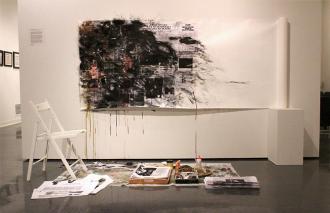Although we live in the supposed land of freedom and liberty, it is difficult in the current political climate to ignore the overarching systems of authority that guide many of the decisions we are allowed make, the social norms to which we are pushed to conform and the way our world is constructed by those in power.
The Worth Ryder Art Gallery’s newest exhibit, “Authority,” seeks to explore this loaded theme by addressing how the many permutations of authority manifest in the lives of individuals and highlighting why it’s so important to bring these issues to light.
In an interview with The Daily Californian, curator Farley Gwazda explained that this theme primarily sprouted from the concerns of the art students, who comprise a fairly politically engaged group. He found additional inspiration in a study he had read, which found a correlation between being a Trump supporter and displaying an attitude of authoritarianism — an issue that Gwazda felt wasn’t really being spoken about. So he, along with three student curators — Rob Borsdorf, Jessica Doojphibulpol (who is an illustrator for The Daily Californian) and Katherine Lo — put this exhibit together in an effort to address the problematic nature of authority and also to give a platform to students whose voices may not always get the opportunity to be heard.
This particular exhibit is the Worth Ryder’s annual open-call student show, showcasing art from 51 students. The open calls seek to acquire a diverse range of voices and pieces, not just those from students in the art department. This was one of the most intriguing things about the exhibit: that each artist had such a unique interpretation of the word “authority.”
“Authority” features an exciting performance piece by Reniel Del Rosario, titled “The Ballot,” which featured 13 confetti-filled piñatas that each represented different human rights that are subject to the control of higher authorities — a diamond ring, a smiley face, a bullet. Accompanying the array of piñatas was another piece by Del Rosario, called “Cast,” which allowed members of the crowd to interact with the piece by whacking the piñatas to the ground. This fun, interactive piece gave people the opportunity to take these human rights issues into their own hands while onlookers cheered in celebration.
In contrast to this rowdy performance, the next room housed a deceptively simple piece from Sabrina Chui, titled “No Gum Allowed,” which features a plain street sign that says, “No Gum Chewing Allowed on Property.” Her piece aims to address the depth of the power of Singapore’s authoritative government, with its control extending to domains such as freedom of speech and LGBTQ+ rights. “Gum is a really small thing, but it shows that control,” Chiu said. The piece also includes a bowl filled with gumballs, which viewers are encouraged to chew and then stick to the sign. She described this act as, “sort of a nice ‘f-you’ ” to the Singaporean government — a small act of rebellion against their rigid authority.
Adding a comical dimension to the exhibit was an impersonator of UC Berkeley Chancellor Carol Christ who called herself “Carrot Christ.” The artist-actress gave an apology speech at beginning of opening night for her “year of free speech” declaration and then continued to walk around the gallery throughout the show, while people occasionally shouted, “Look, Chancellor Carrot Christ is here!” To add to the spectacle, signs were displayed at the gallery’s front room in mock support of the school’s new chancellor, displaying messages such as, “Femmes 4 Christ.” This specific performance piece gave the lofty theme of authority a more local, relevant perspective by directly addressing how systems of authority function at UC Berkeley, specifically in relation to the free speech/hate speech controversy.
The addition of this piece, which is very relevant to UC Berkeley students, highlights one of the curators’ main goals for this exhibit: to create a public gathering space that promotes conversation and community. And in an age in which people often hide behind comments on social media, public assembly has become even more necessary.
While much of the gallery makes an effort to explore the pain and injustice propagated through various systems of authority, it is impossible to ignore how heavily many of the artists focus on the rebellion against this corrosive force. Del Rosario with the smashing of the piñatas, Chiu with the chewing gum filled sign, the satirical presence of “Carrot Christ” and dozens of other notable pieces from the exhibit showed their resistance and defiance to various forms of authority displayed in the artwork.
The entire exhibition itself serves as collaborative act of rebellion by highlighting the fact that that people have always clashed against these authoritative systems. And judging by the lively, engaged viewers at the Worth Ryder, one thing is for sure: People love to reject authority.
Contact Julia Bertolero at jbertolero@dailycal.org.
